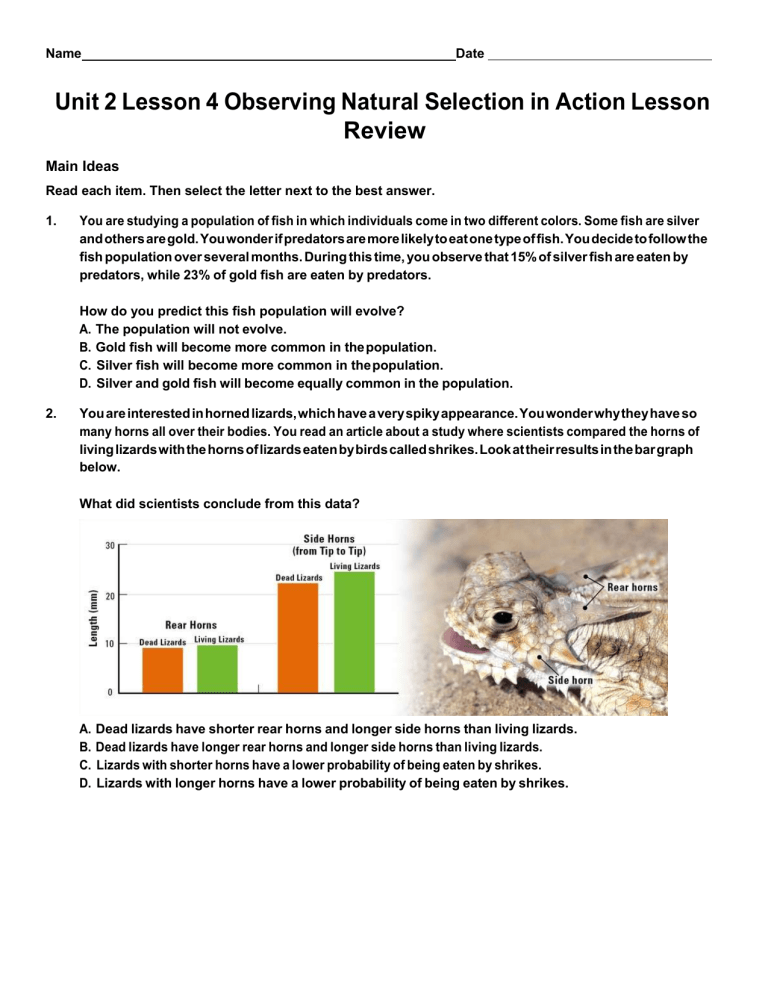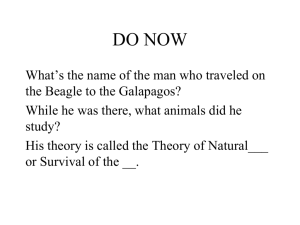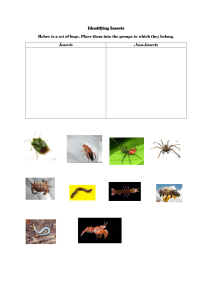
Name Date Unit 2 Lesson 4 Observing Natural Selection in Action Lesson Review Main Ideas Read each item. Then select the letter next to the best answer. 1. You are studying a population of fish in which individuals come in two different colors. Some fish are silver and others are gold. You wonder if predators are more likely to eat one type of fish. You decide to follow the fish population over several months. During this time, you observe that 15% of silver fish are eaten by predators, while 23% of gold fish are eaten by predators. How do you predict this fish population will evolve? A. The population will not evolve. B. Gold fish will become more common in the population. C. Silver fish will become more common in the population. D. Silver and gold fish will become equally common in the population. 2. You are interested in horned lizards, which have a very spiky appearance. You wonder why they have so many horns all over their bodies. You read an article about a study where scientists compared the horns of living lizards with the horns of lizards eaten by birds called shrikes. Look at their results in the bar graph below. What did scientists conclude from this data? A. B. C. D. Dead lizards have shorter rear horns and longer side horns than living lizards. Dead lizards have longer rear horns and longer side horns than living lizards. Lizards with shorter horns have a lower probability of being eaten by shrikes. Lizards with longer horns have a lower probability of being eaten by shrikes. 3. You are studying a population of fish. You notice that some of the males are plain silver, while other males have bright colors. One of the bright males is shown in the photo below, along with a female fish. You discover that females prefer to mate with bright males. As a result, bright males leave an average of 3.5 offspring each. Dull males left an average of 2 offspring each. How do you predict this fish population will evolve? A. B. C. D. 4. The population will not evolve. Dull males will become more common in the population. Bright males will become more common in the population. Dull and bright males will become equally common in the population. You are learning about Kettlewell’s experiments with peppered moths. Kettlewell marked and released dark and light moths in two different environments and then tried to recapture them. Which of the following accurately describes a pattern in the graph? A. B. C. D. In polluted environments, dark moths survived better than light moths. In polluted environments, light moths survived better than darks moths. In unpolluted environments, dark moths survived better than light moths. In unpolluted environments, dark moths and light moths survived equally well. 5. June wants to know why male widowbirds have such long tails. To her, it looks like such a long tail would make it hard for the bird to fly. She asks her teacher about this. Her teacher shows her an experiment where scientists compared three different kinds of male widowbirds: • one group with shortened tails • one group with lengthened tails • one group with normal (unchanged) tails The scientists found that the three groups attracted different numbers of female mates. More mates meant more nests. Look at the results in the graph below. What did scientists conclude from their data? A. B. C. D. 6. Males with shorter tails were able to attract more mates than males with longer tails. Males with longer tails were able to attract more mates than males with shorter tails. Males with shorter tails have a greater probability of surviving than males with longer tails. Males with longer tails have a greater probability of surviving than males with shorter tails. Mosquitoes have become a real problem in your neighborhood. The city is considering spraying insecticides in some key spots. They want to know what some of the consequences for this might be. You find this graph on how spraying DDT affected one mosquito population. Which of the following statements describes the results shown in this graph? A. B. C. D. The percentage of mosquitoes killed by DDT increases over time. The percentage of mosquitoes killed by DDT decreases over time. The number of mosquitoes in the population decreases over time when DDT is sprayed. The number of mosquitoes in the population increases over time when DDT is sprayed. Think Like a Scientist Read about the scientific investigation. Then answer the questions that follow the investigation by selecting the letter next to the best answer. Investigation Walking sticks are insects that live on certain plants in Southern California. They are about 2 centimeters long and are active mainly at night. Interestingly, there are two types of walking sticks: • unstriped insects, found mainly on plants with broad leaves • striped insects, found mainly on plants with thin leaves Scientists wondered if each type of walking stick is better camouflaged on the type of plant it prefers to live on. To test this idea, scientists placed 100 solid walking sticks and 100 striped walking sticks on each type of plant. After 30 days, they counted how many walking sticks had survived. The results are shown in the graph below. 7. What percentage of striped walking sticks survived on plants with broad leaves? A. 16.0% B. 28.7% C. 35.6% D. 51.4% 8. What does the graph show about the survival of unstriped and striped insects? A. Unstriped insects survived better on plants with both thin and broad leaves. B. Striped insects survived better on plants with both thin and broad leaves. C. Unstriped insects survived better on plants with broad leaves, and striped insects survived better on plants with thin leaves. D. Unstriped insects survived better on plants with thin leaves, and striped insects survived better on plants with broad leaves. 9. During a drought, many of the plants with broad leaves die. Plants with thin leaves survive. How do you predict the walking stick population will evolve? A. The entire walking stick population is likely to go extinct. B. Solid walking sticks will become more common in the population. C. Striped walking sticks will become more common in the population. D. Solid walking sticks and striped walking sticks will become about equally common in the population. Expressing Science Practices, Concepts, and Ideas Read the directions for each item carefully and use the space provided to respond. 10. Hummingbirds feed on the nectar of certain flowers. As they feed, hummingbirds also pollinate the plants. This means that they carry pollen from one flower to another, helping the plants reproduce. Plants that are pollinated by hummingbirds often have flowers that are red and trumpet-shaped. The bright color attracts hummingbirds, and the flower shape is well suited to the hummingbird’s ability to hover in the air and feed with its long thin beak. You can see this in the photo below. Write a short response that explains the patterns seen in the hummingbird and the plants it feeds from. In your response, you should: • use evidence in the image to describe the relationship between hummingbirds and the plants they feed from. • explain how a change in one species can affect the evolution of the other species. 11. Look at the peacocks in the photo below. What is the male peacock doing with his feathers? Use the evidence provided in the photo to write a short response that includes: • a claim about whether the male peacock’s feathers help him survive, reproduce, or both. • evidence and reasoning to support this claim. 12. Mosquitoes spread a lot of diseases that are dangerous to humans. People sometimes use insecticides, chemicals that kill insects, to control mosquito populations. The man in the photo below is spraying insecticide near a house. Write a short response that: • explains why mosquitoes evolve resistance to insecticides over time. • explains why combining different strategies for fighting mosquitoes can be more effective at controlling mosquito populations. • includes an example of another strategy that can be combined with insecticides to fight mosquito populations. 13. Antibiotics are medicines that kill bacteria. Sometimes, however, bacteria can evolve resistance to antibiotics. You will illustrate how natural selection results in the evolution of antibiotic resistance in the table below. There is genetic variation in this population, and one bacterium happens to be resistant to the antibiotic ampicillin as shown in Box #1. “Normal” bacteria are shown in blue, and the single “Resistant” bacterium is shown in yellow. Fill in the rest of the table: A. Image #2 shows what happens when the population is attacked using antibiotic ampicillin. Put an X through all the bacteria that die. B. Image #3 shows the survivors. Draw the surviving bacteria population. C. Image #4 shows what happens when the survivors reproduce. Draw the new bacteria population. D. Write a caption below the image explaining how the bacteria population has evolved.


